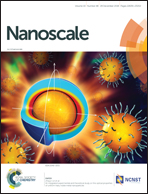WSe2 nanoparticles with enhanced hydrogen evolution reaction prepared by bipolar electrochemistry: application in competitive magneto-immunoassay†
Abstract
Among groups of layered nanomaterials, transition metal dichalcogenides (TMDs) are the most studied group, especially for their hydrogen evolution reaction (HER) electrocatalytic activity and good stability in a highly corrosive environment. However, TMDs possess only low catalytic activity in the bulk form consisting of 2H phase, therefore, exfoliation must take place to enlarge the surface area and create new catalytically active sites (edges and defects). The most common exfoliation routes use organometallic reagents, such as tert-butyllithium (t-BuLi). Recently, bipolar electrochemistry (BE) was reported as a new efficient exfoliation and down-sizing technique applied on several layered materials. In this work, we used BE for further down-sizing of WSe2 micro-sheets, which were pre-exfoliated using tert-bulyllithium intercalator, down to nanoparticles (NPs). These WSe2 NPs outperformed t-BuLi exfoliated particles in terms of the overpotential needed for HER electrocatalysis. Moreover, WSe2 NPs were used effectively as a label for a competitive magneto-inmunoassay. This competitive magneto-immunoassay offers high selectivity with a wide linearity range, high sensitivity and a low limit of detection. We believe that such labels possess a great potential for bioassays.



 Please wait while we load your content...
Please wait while we load your content...